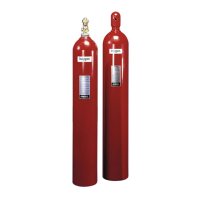Class A Surface Fuels 34.2%
Class B Fuels Heptane 40.7%*
Class C Fuels 34.2%
APPLICATION METHOD (Continued)
Total Flooding (Continued)
STEP NO. 3 – Calculate Reduced Volume
Subtract the volume of solid, permanent objects (Step No.
2) from each of the hazard’s volumes (Step No. 1). The
result is considered to be the Reduced Volume for the
enclosure.
Volume – Solid Object Volume = Reduced Volume
Complete this step for each area protected by the system.
Example
Computer Room:
• 2,600 ft
3
– 100 ft
3
= 2,500 ft
3
Subfloor:
• 260 ft
3
– 10 ft
3
= 250 ft
3
STEP NO. 4 – Determine minimum design concentra-
tion
Minimum Design Concentration is defined by NFPA 2001
as the Extinguishing Concentration plus a safety factor,
depending on the fuel. Extinguishing Concentration is the
agent concentration required to extinguish a test fire.
The Minimum Design Concentration for various fuels is
shown in the following table:
INERGEN Minimum Design Concentrations
* Contact Ansul Technical Services Department for Minimum Design
Concentrations for other Class B fuels.
Class A, B (contact Ansul for types), and C hazards are UL
listed for INERGEN systems.
Complete this step for each area protected by the system.
Design Concentrations are determined by NFPA 2001,
2000 edition, Paragraph 3-4.2 and UL-2127, first edition,
Paragraph 59.2(b):
INERGEN cupburner value is 31% for commercial grade
Heptane
Nozzle distribution test concentration = 31.25%
Calculations:
Cupburner or fire test concentration x nozzle efficiency
factor x safety factor
Nozzle efficiency factor = 31.25 = 1.008
____
31.0
Safety Factor: Class A = 1.2
Class B = 1.3
Class C = Class A
For Class A (determine by fire test) – 28.24% x 1.008 x
1.2 = 34.2%
For Class B (commercial grade heptane) – 31.25% x 1.3
= 40.7%
For Class B (other Class B fuels) – cupburner x 1.008 x
1.3 = design concentration
For Class C = Class A
For systems with only manual actuation – cupburner or
fire test concentration x 1.008 x 1.3 = design concentra-
tion
STEP NO. 5 – Determine minimum quantity of
INERGEN agent required
This step is used to determine the minimum amount of
INERGEN agent required to protect each hazard area. The
amount of agent calculated during this step is the minimum
amount of agent that is required to protect the hazard area.
The amount of agent in the system must always be at least
this much and may be exceeded. Failure to supply at least
the amount of agent indicated in this step may prevent the
system from suppressing a fire.
To determine the minimum quantity of INERGEN agent
required, determine the lowest anticipated ambient temper-
ature for the area being protected and determine the
design concentration required for the material to be extin-
guished. Minimum Ambient Temperature is defined as the
lowest anticipated temperature in the enclosure during nor-
mal conditions and is usually determined by the environ-
mental conditions or the air handling system. This temper-
ature is used in the design because it is the “worst case,”
meaning that it will require the highest amount of agent.
SECTION V
UL EX-4510 7-15-02 Page 5-2
REV. 1
Design

